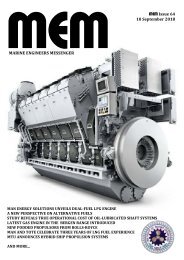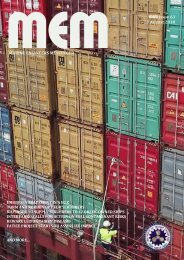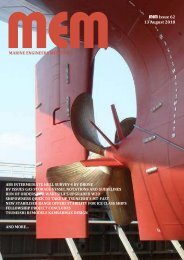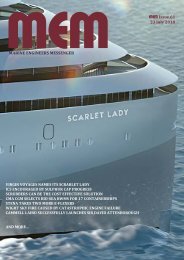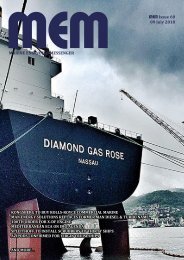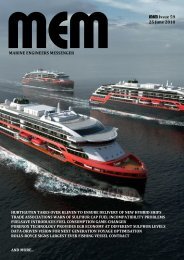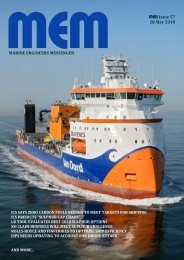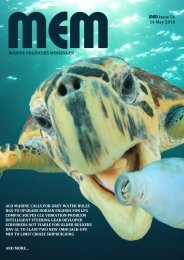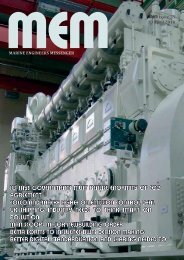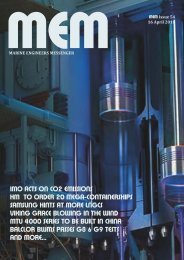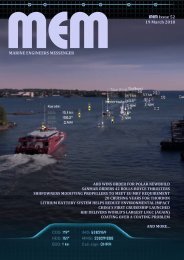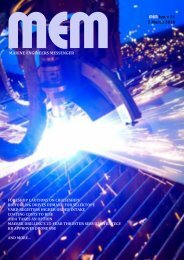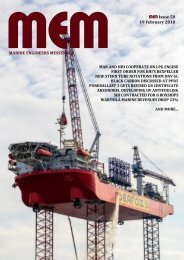You also want an ePaper? Increase the reach of your titles
YUMPU automatically turns print PDFs into web optimized ePapers that Google loves.
SAFETY<br />
SEWOL STUDY COMPLETE<br />
Dutch model basin MARIN has<br />
completed its study into the<br />
capsizing of the Korean ferry<br />
Sewol. The ferry capsized and sank<br />
near the South Korean coast in<br />
April 2014. 304 souls were lost.<br />
Working with Korean Sewol<br />
Investigation Commission (SIC) to<br />
determine the causes of the<br />
capsizing and rapid sinking,<br />
MARIN carried out a series of<br />
model tests and simulations using<br />
scale models of the vessel in<br />
MARIN's test basins in<br />
Wageningen. Initially, a 5m<br />
freeform model was built. Shifting<br />
containers, cars and trucks were<br />
also modelled. Subsequent tests<br />
were carried out with a 5m long<br />
model in which all compartments,<br />
tanks and inflow openings were<br />
accurately reconstructed to scale<br />
to investigate flooding and<br />
sinking. Finally, the influence of<br />
orders and interventions of the<br />
officers on the bridge were<br />
examined using a large navigation<br />
simulator.<br />
MARIN's research leader Henk van<br />
den Boom, said: "Major ship<br />
disasters such as those like the<br />
Estonia, Herald of Free Enterprise<br />
and 'Sewol' require a thorough<br />
investigation so that we<br />
understand what exactly<br />
happened and determine how we<br />
can prevent this in the future. We<br />
will analyse the results in the<br />
coming weeks and then we hope to<br />
be able to identify the causes. The<br />
conclusions of this study will also<br />
be of importance for new national<br />
and international regulations for<br />
ferries and cruiseships. "<br />
CHAINS<br />
ANCHORS AWAY FOR AKF<br />
Marking a return to production<br />
for the high-end yacht<br />
industry, Damen Anchor &<br />
Chain Factory (AKF) has<br />
delivered two galvanized yacht<br />
anchors. AKF carried out the<br />
fabrication, Class approved<br />
testing, and galvanization of the<br />
anchors – each weighing<br />
1080kg – within two weeks of<br />
receiving the order.<br />
“We decided to return to our<br />
roots and start producing yacht<br />
anchors here in Schiedam, the<br />
Netherlands. Production of<br />
yacht anchors is for a large part<br />
about the small details, and inhouse<br />
production allows us to<br />
be on top of the whole process,”<br />
said Laurens van Gelder,<br />
Managing Director of AKF.<br />
Production of these two yacht<br />
anchors began with delivery of<br />
the steel plating from<br />
metalworking company Kroon<br />
Metal Technology. Within one<br />
week of ordering the material,<br />
the anchors were ready for Class<br />
inspection, weld checking, and<br />
proof load testing on our own<br />
test benches before delivery to<br />
the client.<br />
LIFEBOAT MANUFACTURER WARNS DEADLINE LOOMS<br />
Norsafe, the survival craft<br />
manufacturer, has urged<br />
shipowners to ensure that all<br />
ships’ on-load lifeboat release<br />
mechanisms comply with<br />
SOLAS Resolution MSC.317(89)<br />
by 1st July 2019.<br />
In some instances, this may<br />
mean that a lifeboat’s release<br />
and retrieval system have to be<br />
modified or replaced on or<br />
before that date, normally at<br />
the next scheduled dry-docking,<br />
as only hooks certified and<br />
tested in compliance with the<br />
aforementioned SOLAS<br />
resolution and named in the<br />
IMO GISIS database will be<br />
allowed on any lifeboat with<br />
onload hooks.<br />
Norsafe’s global servicing<br />
and maintenance teams can<br />
ensure release mechanisms are<br />
compliant.<br />
19




